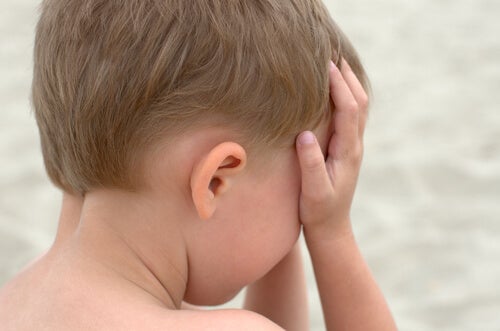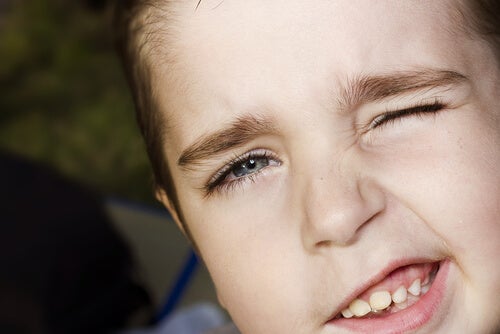Tics in Childhood: Characteristics and Treatment

Tics are involuntary, recurrent, unpredictable, non-rhythmic muscle movements that can be temporarily controlled by willpower. Tics in childhood tend to worsen due to stress or anger and can be reduced by distraction or concentration.
In reality, tics are one of the most common motor disorders in children. The involuntary part of a tic seems to be the initial impulse, and the movement is often carried out to relieve the impulse. However, younger children with rapid, repetitive tics describe them as a sudden occurrence they can’t control.
How they evolve
Tics usually begin between the ages of four and seven. For most children, the first tics take the form of repetitive blinking, sniffing, throat clearing, or coughing. They’re more frequent in males than females, with a ratio of 3 to 1.
Tics vary considerably in their severity and frequency. However, many children between the ages of 4 and 6 with minor and transient tics won’t seek medical attention. In approximately 55% – 60% of young people, these tics will barely be noticeable by the end of adolescence or early adulthood.
In another 20-25%, the tics become less frequent, and, finally, in the remaining 20%, the tics continue into adulthood. Some of these adults will even report that the tics worsen.
Clinical characteristics of tics in childhood
Certain characteristics define these motor movements:
- The tics get worse with anxiety, tiredness, illness, excess emotions, and excessive screen time.
- Tics tend to reduce when a child engages in a cognitively demanding and interesting task.
- Exercise will reduce tics, especially during the duration of physical activity.
- Tics won’t interfere with important actions or activities, neither will they lead to falls or injuries.
- There are tics that have the name of blocking tics that can lead to these things, and, in this case, you should go and see a doctor who will diagnose why they’re occurring.
- You can notice a considerable difference in the tics when someone is filming the sufferer.
- They usually happen to people with personality disorders as well as in dysfunctional families.
- The children may experience a sense of pleasure that’s expressed facially.
- Sufferers feel that they can’t suppress them.
- They have no sense of when the movements will occur.

Classification of tics
Tics are classified as motor or vocal and simple or complex. Simple tics are manifested by sudden movements or short, repetitive sounds. Complex motor tics are coordinated, inappropriate, and sequential movements. For example, repeated shaking of the head, repeating the gestures of others (echopraxia), or making obscene gestures (copropraxia).
Complex vocal tics are usually carried out in an inappropriate setting. An example of this would be the repetition of syllables, blocking people’s words, the repetition of their words (palilalia), repeating words they hear (echolalia), or using obscene words (coprolalia).
How tics are classified in the DSM-5
- Provisional tic disorder (transient). Motor or vocal tics (or both) that have occurred for less than one year.
- Chronic tic disorder. Single or multiple motor or vocal tics present for more than one year.
- Tourette syndrome (TS). Multiple motor tics along with vocal tics that have lasted more than a year. They don’t necessarily have to be present simultaneously, nor follow a growing pattern.
Concurrency in childhood tics
Children with tics are generally unable to control their impulses. There are subtle differences in neuropsychological and motor functioning, as well as a high rate of psychiatric or developmental comorbidities (where one or more conditions or symptoms are present). These include:
- ADHD (30% to 60%)
- Compulsions (30% to 40%)
- Anxiety (25%)
- Disruptive behavior (10% to 30%)
- Mood disorders (10%)
- Obsessive-compulsive disorder (5 to 8%)
- Autism spectrum disorder (5%)
- Motor coordination difficulties
- Bouts of rage
Etiology
Tics have a complex multi-genetic etiology and are highly hereditary. The concordance between monozygotic twins is 87%.
In the past, tics were considered to be related to behavior or stress and often called “nervous habits” or “contractions”. Experts now know that tics are neurological movements that can be worsened by anxiety but not caused by it.
The underlying mechanisms involve several neural networks in the brain, between the cortex and the basal ganglia (fronto-striatum-thalamus circuits). However, they also involve other areas of the brain such as the limbic system, the middle brain, and the cerebellum. Abnormalities in interoceptive awareness and central sensorimotor processing have also been described.
Treatment of childhood tics: Behavioral interventions
Behavioral interventions include several techniques. However, the specific treatment that each child needs will depend on the initial evaluation, the response to the treatment, and the incidents that arise during it (Bados, 2002).
Habit reversal therapy (HRT) and exposure and response prevention (ERP) are evidence-based interventions for tics. HRT and ERP will reduce the combined severity and frequency scores (Yale Global Tic severity score) between 40% and 50%.
Habit inversion treatment
The habit inversion treatment proposed by Azrin (Azrin and Peterson, 1988) involves teaching the patient to recognize the impulse before the manifestation of the tic. They then teach them to carry out an action called a competitive response that reduces the chances of their tic occurring.
It includes 11 main techniques organized in five phases:
- Awareness. This includes being aware of the stimuli and situations that precede the manifestation of the tic.
- Describing the tic in detail and then training oneself to do this on a regular basis.
- Learning self-observation training in order to detect the tic when it occurs.
- Early detection – training in how to detect the sensations that precede the tic.
- Detection of dangerous situations in which the tic is more likely to occur.
- Relaxation training.
- Training you to respond in a way to prevent the tic from manifesting. This treatment’s aim is the following:
- Preventing the tic from manifesting itself.
- Keeping it away for several minutes.
- Making the person increasingly aware of the situations that the tic manifests in and its characteristics.
- The methods should be socially acceptable.
- They should also be compatible with a person’s normal day to day activities.
- It should strengthen these “enemy” muscles that are involved in producing the tic so that they’re strong enough to avoid making these involuntary movements.
- The training will usually consist of isometrically tensing the muscles that oppose the tic movements.
Motivation
- Motivation. This phase is for both the patient and the family. It includes three standard motivation techniques:
- Going over the negative effects of the tic.
- Social support. This includes a person close to you getting involved and helping you to carry out the procedure.
- Carrying out these training methods in public.
- General training. This includes the patient having to imagine themselves performing the exercises in different dangerous situations identified in phase 1.

Exposure therapy with response prevention
The practice of being able to prevent the exposure and response of the tics leads to the need for conditioning. This therapy, therefore, encourages the patient to feel and endure the need for the tic (exposure) without producing the tic (response prevention). In a session of a certain fixed duration, the therapist asks the patient to try to hold back and prevent the tics. Then, they record how long they can do it for.
There’s no set time they have to achieve. Patients have a lot of help in each session, and the length of time during which they’re able to control the tics lengthens progressively.
Using exposure therapy with response prevention on a regular and systematic basis gives the patient practice in holding back the tic’s impulses. Over time, the patient’s ability to control tics improves. During the session, the therapist asks the patient how strong the impulses are. This exposes them to the anguish of having a tic, despite only talking about it.
Pharmacological treatment of tics in childhood
The decision to use medication depends on the nature of the tics and doctors generally only use them for serious and annoying tics that cause pain or injury. Current evidence shows clonidine (a presynaptic alpha-2 agonist) to be the first-choice medication.
In contrast, antipsychotics or antidopaminergics seem to be more effective in adults. Clinical practice supports good results for Aripiprazole in children.
Although doctors don’t usually resort to benzodiazepines to treat tics, they do sometimes in acute and serious cases. They can use them as a way of reducing anxiety when the tics appear, but it’s preferable not to use them as there may be a knock-on effect which can cause other problems.
All cited sources were thoroughly reviewed by our team to ensure their quality, reliability, currency, and validity. The bibliography of this article was considered reliable and of academic or scientific accuracy.
- Aicardi J. Other neurosychiatric syndromes. In: Aicardi J (ed). Diseases of the nervous system in childhod. New York: Mc Keith Press; 1992. p. 1338-1356
- Moreno Rubio JA. Tics en la infancia. Rev Neurol 1999;28(Supl 2):S 189-S191.
This text is provided for informational purposes only and does not replace consultation with a professional. If in doubt, consult your specialist.








